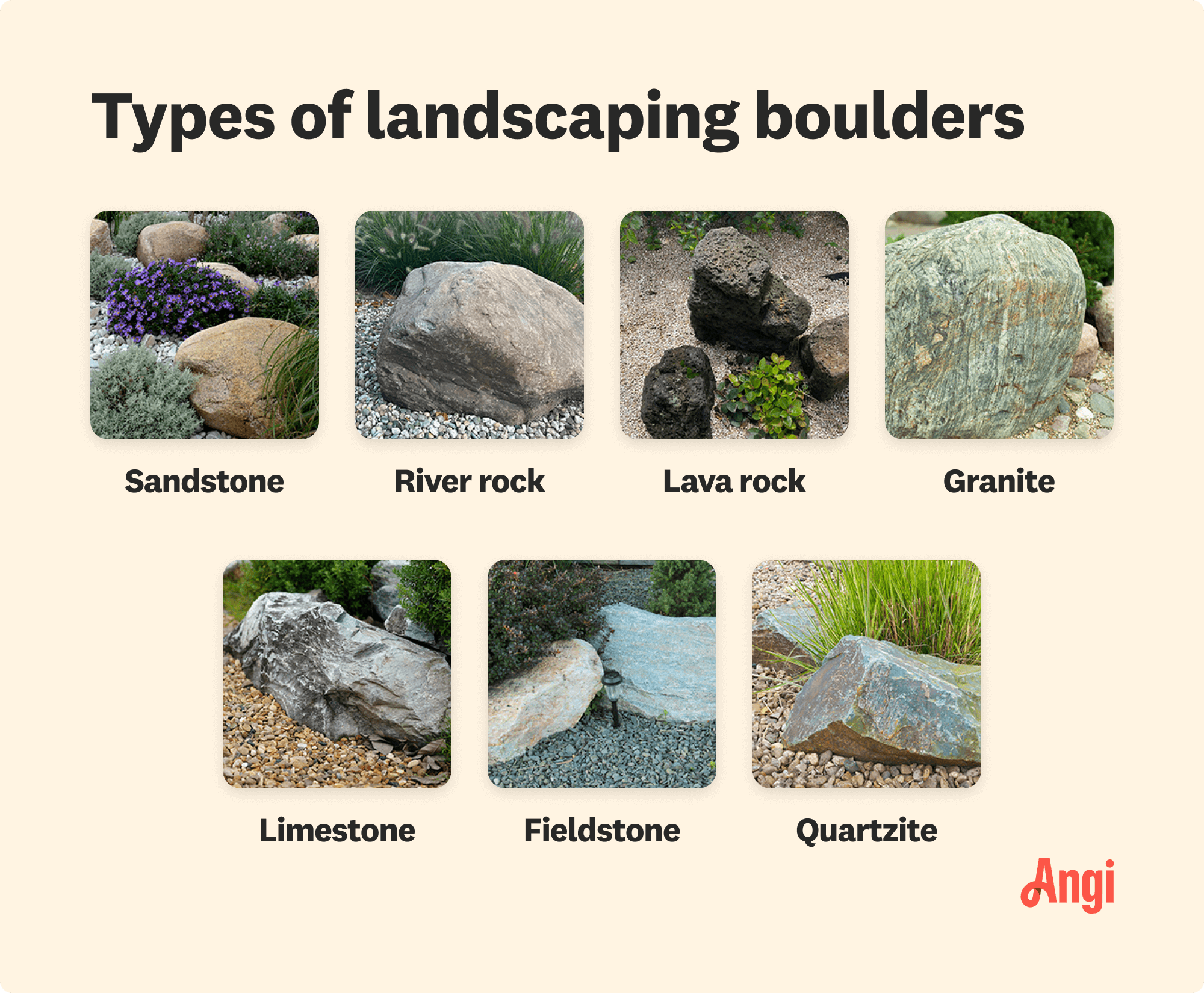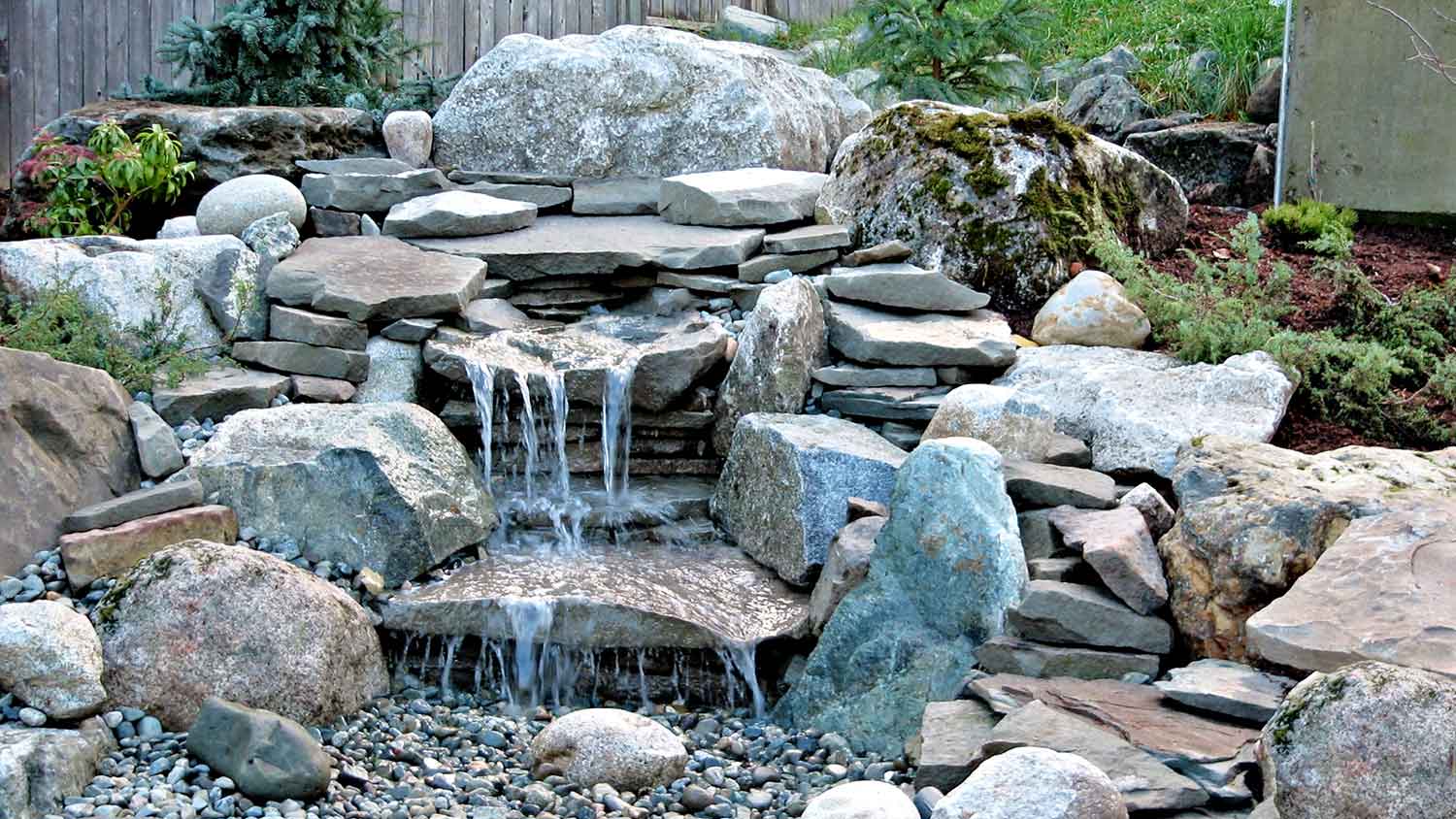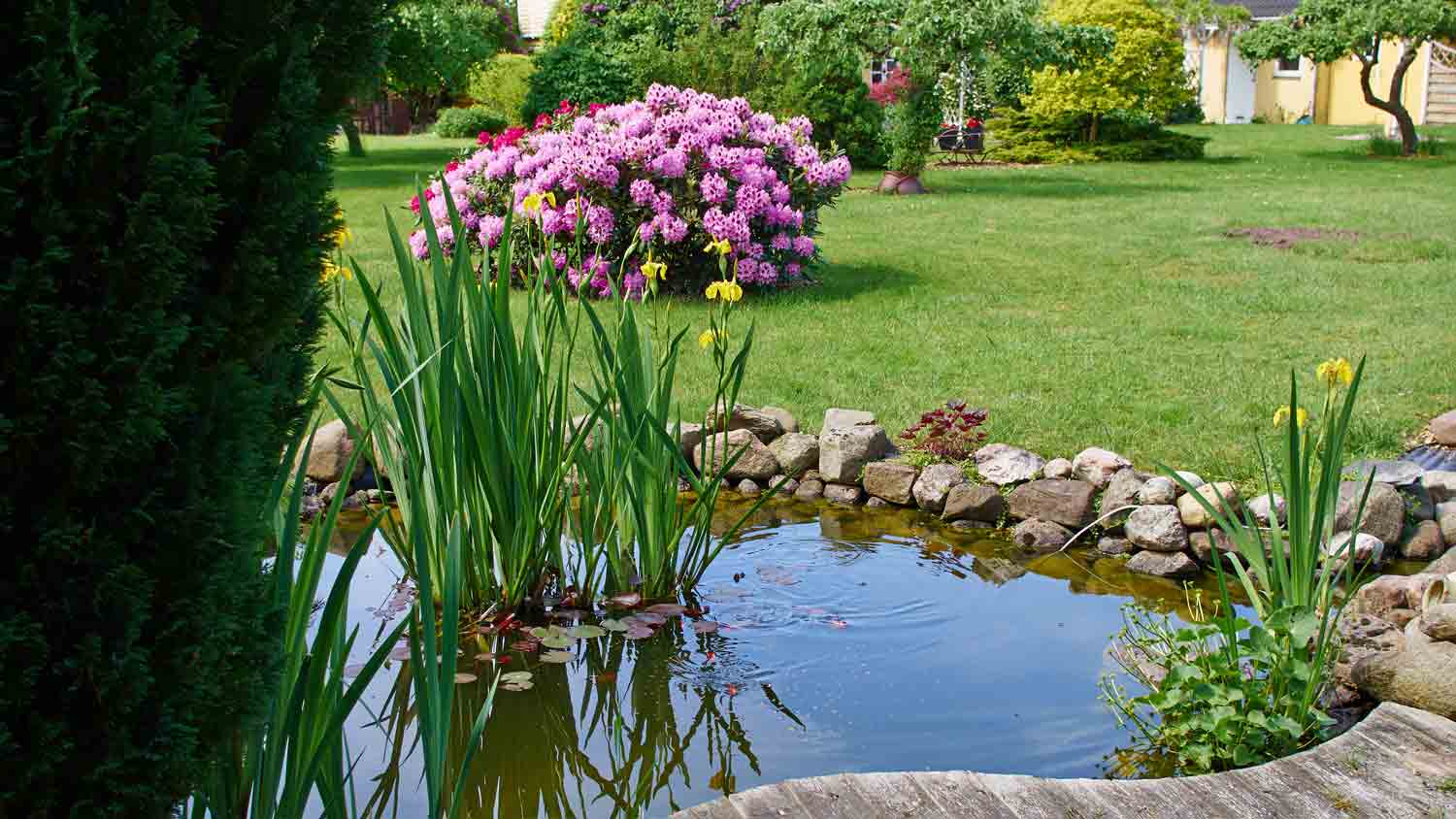
How much does hardscaping cost project by project? Check out our breakdown for every price tag you need to know, from outdoor fireplaces to patios.
Landscape boulders cost $150 to $350 per ton, or around $250, on average, but prices vary based on color, shape, and rarity.


The cost of landscape boulders depends primarily on size and weight, with small, 10-inch varieties starting around $3 each and large multi-ton ones costing up to $3,000.
If you're purchasing boulders by weight, you’ll pay between $60 and $600 per ton, on average, depending on the type of stone you choose.
Labor and delivery costs add an average of $150 to $2,500, depending on access, project size, and the need for heavy equipment.
If necessary, preparing your site for boulder installation can be a significant cost factor, ranging from $1,000 for minor regrading tasks to $6,000 or more for full-scale excavation work.
Landscape boulders cost an average of $250 per ton or between $50 and $180 per cubic yard. You can pay as little as $100 or as much as $600 per ton, depending on the type and shape of the boulders you use. Landscape boulders can add a striking focal point to your yard, help to create defined outdoor spaces, or be used to construct a retaining wall. Learn what factors contribute to what you’ll pay for landscaping boulders.
Landscape boulder installation is considered a hardscaping project, and there are a few factors that will influence the total cost of the project. Though the average landscape boulder costs around $250 per ton, the price for a single stone can rise into the thousands.
Landscape boulders cost more than other types of landscaping rocks because they’re much heavier and require more labor to maneuver into place.
The size of each boulder will influence the price because larger, bulkier rocks may also demand the use of special equipment like cranes to lift them into place. You can use the table below to get a rough estimate of your landscaping boulder cost by size.
| Boulder Diameter (in.) | Average Cost |
|---|---|
| 10 | $3–$10 |
| 12 | $5–$15 |
| 15 | $10–$30 |
| 20 | $20–$60 |
| 24 | $30–$180 |
| 30 | $50–$200 |
| 36 | $100–$350 |
| 40 | $200–$650 |
| 48 | $250–$800 |
| 49 or more | $1,000+ |
The weight of the landscaping boulders you choose will also play a role in how challenging they are to deliver and maneuver into place. You might also need to go based on weight if your boulders will be oblong or if the shape makes it challenging to measure.
Most boulders for landscaping purposes weigh around 150 pounds per cubic foot—though certain stones can cost more. You can expect to spend anywhere from $3 for a small boulder to more than $2,500 for a large boulder, not including installation and delivery.
| Landscape Boulder Weight | Average Cost |
|---|---|
| 50 pounds | $3–$15 |
| 150 pounds | $7–$45 |
| 250 pounds | $13–$75 |
| 500 pounds | $25–$150 |
| 1000 pounds | $50–$300 |
| 1 ton | $100–$600 |
| 2 tons | $200–$1,200 |
| 5 tons | $500–$3,000 |

Boulders vary in price based on type, with rarer stones, colors, and patterns costing more. Location also plays a role. Since transporting heavy objects comes with significant transportation costs, you’ll pay less for stones quarried locally. In fact, certain stones may only be available in certain regions. Stones imported from another country can cost two to four times the price of local stones.
When choosing a boulder for your yard, look at your other hardscaping features. You can match your new boulders to existing pavers, stone walkways, or local terrain.
| Type of Landscape Boulder | Average Cost (per Ton) |
|---|---|
| Sandstone | $60–$300 |
| River rock | $100–$350 |
| Lava rock | $100–$600 |
| Granite | $125–$600 |
| Limestone | $130–$500 |
| Fieldstone | $250–$600 |
| Quartzite | $300–$600 |
Suppliers often have a minimum order, so you could end up with more stones than you need. Though you can buy individual boulders from certain retailers, you’ll usually only be able to buy them by the ton. If you want to purchase smaller stones, you may be able to buy them by the pound, cubic yard, or pallet (most pallets hold 1 1/2 tons, but it depends on the size of the stones).
You’ll often pay more per ton for smaller quantities because of the minimum order, although delivery costs increase with the quantity of stones.
You may have to prep the area before installing your landscape boulders, like if you need land regrading or excavation to prepare the area around your foundation or develop a retaining wall. Of course, you might not need any of these services if you’re just placing landscaping boulders in the existing garden bed.
| Preparation Method | Cost |
|---|---|
| Clearing land | $1,300–$5,700 |
| Excavation | $1,500–$6,000 |
| Flattening slopes | $1,000–$5,000 |
| Regrading | $1,000–$3,000 |
Even if you plan on moving the boulders into place yourself, delivery costs depend on the quarry's location and the stone's weight, so you will still need to contact a local rock delivery service to get an accurate quote. A rock delivery specialist can get your boulders to the right spot in a safe and efficient manner.
Most people spend between $150 and $2,500 on delivery and installation of landscaping boulders, but it depends on the number of boulders and the scale of the project. You’ll typically need to hire a landscaper with specialized equipment given the weight of larger stones, but moving stones weighing over 150 pounds requires multiple workers and increases the labor cost. Your prices will also move upward if you need your boulders installed in tight areas around your home or if there’s limited access for heavy equipment to the installation site.
Even if you plan on moving the boulders into place yourself, delivery depends on the quarry's location and the stone's weight, so you will still need to contact a local rock delivery service to get an accurate quote. A rock delivery specialist can get your boulders to the right spot in a safe and efficient manner.
The beauty of landscaping boulders is that they’ll last indefinitely, and you can usually just leave them as-is once installed without maintenance. However, you might want to budget for some ongoing maintenance services if you want your yard to look as clean and manicured as possible.
| Maintenance Item | Cost |
|---|---|
| General cleaning | $25–$120 each |
| Moss removal | $30–$150 each |
| Sealing | $20–$80 each |
You can save $50 to $75 per hour on labor—or a total of between $500 and $500 per boulder—if you install landscaping boulders on your own, but unless you’re installing very small boulders, DIYing this project can get dangerous quickly. Boulders are extremely heavy, and delivering and installing them yourself could lead to injury, especially if you don’t have professional equipment to maneuver the boulders. Even professional landscapers use a team along with specialized equipment to help offset the weight.
On top of that, installation may be a part of a professional landscape design. Often, homeowners will use boulders for retaining walls or to help with drainage, and these setups require professional knowledge. A local landscaping company can avoid potential problems (like the risk of injury or property damage) with loose or improperly installed stones.

Again, installing landscaping boulders may be part of a larger landscaping project that comes with some extra costs. Here are some considerations you may want to add to your budget.
| Landscape Boulder Add-Ons | Average Cost |
|---|---|
| River rock delivery and installation | $500–$800 |
| Landscape curbing | $800–$2,100 |
| Mulching | $30–$150 per cubic yard |
| Planting flowers in mulch | $800–$3,000 |
| Planting trees | $100–$2,000 |
| Retaining walls | $3,200–$9,200 |
| River rock delivery and installation | $500–$800 |
| Water features | $950–$4,800 |
| Xeriscaping | $3,000–$24,000 |
Landscaping boulder installation often accompanies other landscaping jobs, and costs can rack up quickly. If you need to tighten your budget, here are some helpful tips:
DIY some of the work: You may not be able to install a 500-pound boulder on your own, but you can save on labor costs by doing some of the smaller landscaping jobs, like making your own mulch and planting flowers around the installation site.
Choose stones from a local quarry: Avoid costly delivery fees by choosing stones readily available in your area.
Choose smaller stones: Smaller stones are simpler to install, so you may save on installation costs by sticking to a plan using smaller boulders that weigh less. You could even deliver and install them yourself to maximize your savings.
Looks for sales: Some landscaping retailers run sales on stones and other landscaping projects, usually in the fall when landscaping season is over. Instead of choosing a rare or high-end stone, choose one that is on sale but still looks good with your landscaping.
Keep your project minimal: Instead of doing a complete overhaul, go with a landscape design that will make the largest impact for the lowest cost. You don’t always need an extensive project to make a big difference.
Home is the most important place on earth, which is why Angi has helped more than 150 million homeowners transform their houses into homes they adore. To help homeowners with their next project, Angi provides readers with the most accurate cost data and upholds strict editorial standards. We extensively research project costs to develop the pricing data you see, so you can make the best decisions for you and your home. We rely on reputable sources, including the U.S. Bureau of Labor Statistics, academic journals, market studies, and interviews with industry experts—all to ensure our prices reflect real-world projects.
Want to help us improve our cost data? Send us a recent project quote to [email protected]. Quotes and personal information will not be shared publicly.
From average costs to expert advice, get all the answers you need to get your job done.

How much does hardscaping cost project by project? Check out our breakdown for every price tag you need to know, from outdoor fireplaces to patios.
.jpg?impolicy=leadImage)
Landscaping your yard adds curb appeal and expands your home’s living space into the outdoors. Learn how much landscaping costs for various projects.

Growing plants with a hydroponic gardening water system can be a big investment. To know how much it costs to build a hydroponic garden, consider the system, technology, size, and whether you hire a pro. This guide will help calculate costs.

It’s natural to judge, but which home aspects get the most criticism? From lawn care to messiness, find out what homeowners really judge the most.

When building a pond, you’ll have to choose a pond liner, which come in various materials and sizes. So, what size pond liner do you need? Let’s break it down.

While it’s possible to DIY build a retaining wall, several pros have advanced knowledge of hardscaping and building. Learn who to hire to build a retaining wall.